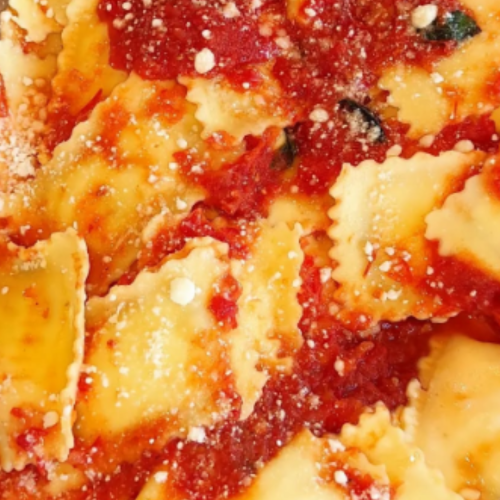Method: Step-by-Step
Making the Dough
Forming the Dough: Create a well in the center of the flour. Add eggs, yolks, olive oil, and salt to the well. Use a fork to incorporate the flour gradually.
Kneading: Knead the dough until smooth and elastic (about 10 minutes). If using a stand mixer, knead on medium speed for 5 minutes.
Resting: Wrap in plastic wrap or place in a covered bowl. Let it rest at room temperature for 30 minutes.
Preparing the Filling
Combine the ricotta, Parmigiano, lemon zest, nutmeg, egg, salt, and pepper in a bowl.
Mix until smooth and set aside.
Rolling the Dough
Divide the dough into four pieces. Roll out each piece using a rolling pin or pasta machine, working to the thinnest setting (about 1/8 inch thick).
Assembling the Ravioli
Lay one sheet of dough on a floured surface. Spoon small mounds of filling (~1-2 teaspoons each) evenly spaced on one half.
Brush around the filling with beaten egg. Fold the dough over, pressing gently to seal and remove air pockets.
Cut into ravioli shapes using a pastry cutter. Place on a floured tray to prevent sticking.
Cooking the Ravioli
Bring a large pot of salted water to a gentle boil.
Add the ravioli and cook for 2-3 minutes until tender. Remove using a slotted spoon.
Serving
Serve immediately with your favorite sauce. Popular options include brown butter and sage, light tomato sauce, or olive oil with a sprinkle of Parmigiano.
Variations and Tips
Spinach-Ricotta Filling: Add finely chopped cooked spinach to the filling for a classic twist.
Gluten-Free Option: Use a gluten-free flour blend for the dough.
Lactose-Free Substitution: Swap ricotta for a lactose-free soft cheese and omit Parmigiano if necessary.
Freeze for Later: Assemble ravioli and freeze on a baking sheet before storing in a bag. Cook directly from frozen.
